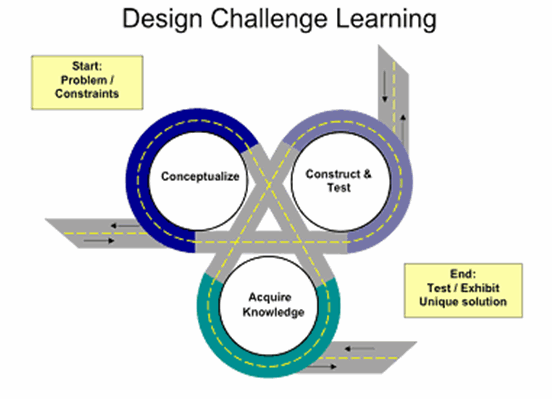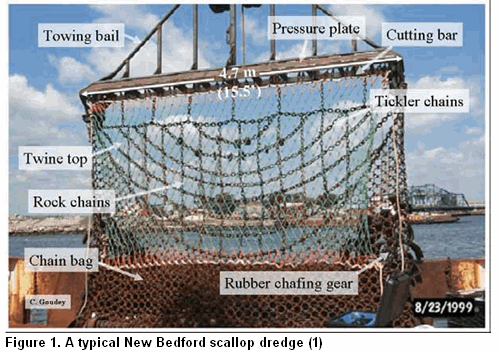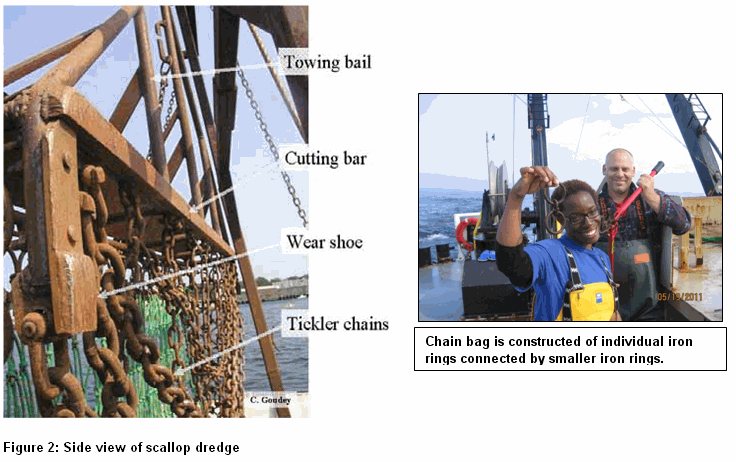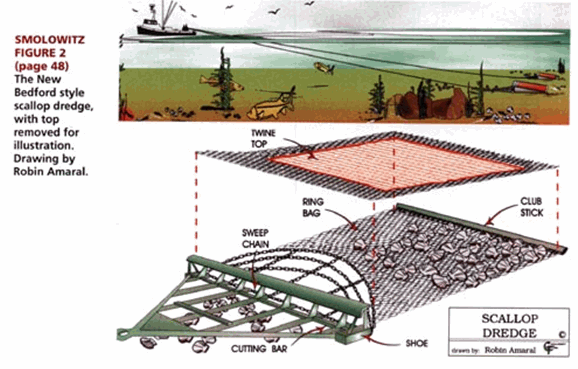
Atlantic Sea Scallop Dredge Design Challenge
Urban Assembly Academy of History & Citizenship for Young Men, Bronx
Summer Research Program for Science Teachers
August 2011
Subject: Biology
Grade Levels: 9-10
Introduction: This is lesson number six in a series on sea scallops. In this lesson, student will be challenged to design a sea scallop dredge to collect scallops within a given set of constraints and conditions. The lesson can be completed in five 50 minute periods. For the entire series, contact: channacomer@yahoo.com
Objective:
Understanding of human activity on ocean ecosystem
Development of critical thinking and problem solving skills
Understanding of the design and engineering process
Materials:
Per Class
·
Paper towel
·
Plastic tablecloths to cover tables
Per
team
10 straws
15 Hex nuts (2 sizes)
netting
5 ft string
40 paperclips (2 sizes)
scissors
ruler
graph paper for sketching diagram
chart paper and markers for brainstorming
Samples of objects used to simulate scallops (one of each size)
Simulated ocean floor
30 gallon fish tank with sand bottom, filled with water
Various objects to represent sea life (plants and animals)
Small round objects in various sizes to simulate scallops (e.g.; glass beads)
·
Videos*
*If your school has a firewall that prevents you from accessing You Tube videos,
you can use any free video conversion site (like
this one) to convert the video into and FLV file which can be opened on any
video viewer installed on your computer.
Background:
The diagram below represents the engineering and/or design process. Teams do not
follow a linear path from problem to solution, but rather weave in and out of
conceptualizing, constructing and testing, and acquiring knowledge, all the
while applying multiple skills and habits of mind of innovators. Through the
Design Challenge process, students have the opportunity to build broad skills
useful throughout their lives, regardless of the specifics of the challenge. In
using this open-ended approach that leads to the creation of numerous designs,
students are challenged to apply their domain knowledge, personal experiences,
interests and talents to the process of creating an inventive, team driven
solution. This approach creates a powerful learning experience, where students
are intrinsically inspired to learn and have pride in achieving a goal as a
team. In a traditional design approach, students would research before
developing potential solutions. Your order will depend on the goal of the design
challenge and your students.

Conceptualize
Identify problem, materials, & constraints
Brainstorm ideas and possible solutions
Construct & Test
Acquire Knowledge
Sea Scallop Dredge
It is acknowledged by nearly everyone working on the ocean that fishing gear
causes some alteration of the seabed, although the significance and duration of
this alteration continues to be debated. In the absence of clear scientific
evidence, qualitative rankings of relative impacts of different fishing gears
have been made based on observations and experience. Scallop dredges are
generally felt to have a large impact compared to other gears.
The Atlantic sea scallop Placopecten magellanicus industry contributes
significantly to the economy of New England. The Northeastern United States sea
scallop fishery landed over 60 million pounds of scallop in the 2005-2006
season. This stock now produces a value of over $300 million annually. In 2005,
the overall biomass of scallops exceeded BMSY and was therefore no longer
overfished.
Scallop dredges used in New England are constructed of heavy steel bar welded
into a triangular-shaped frame, with a bag hung from the back made of steel
rings (Figures 1 & 2). Current regulations require a 4” ring for scallop size
selectivity and a 10” twine mesh on the upper side to reduce finfish by catch.
The dredge rides along the sea floor on shoes welded to the dredge at the
corners of the triangle where the bag is attached. A pressure plate is mounted
along the top rear of the triangular frame to provide some downward hydrodynamic
pressure, however, the weight of the frame and chain bag is the predominant
downward force assuring bottom contact. A cutting bar (Figure 2) provides
structural support to the dredge and plays a much debated role in scallop
capture. From underwater video, it is known that the cutting bar can remove the
tops of bottom features such as small sand dunes.
The underside of the chain bag is supported by a chain sweep that hangs in a catenary from either side of the frame. As shown in the photo, it is also common to have tickler chains preceding this sweep chain, presumably in order to lift scallops from the bottom in anticipation of the approaching chain bag. Also shown are rock chains intended to prevent rocks and boulders from entering the bag and damaging the gear and the catch.



The combined weight and amount of hardware in contact with the seabed explains why this type of gear is singled out as uniquely damaging to ocean habitat. Yet, the economic significance of the east coast sea scallop fishery and the traditional use of this gear make the adoption of alternate gear challenging. In spite of this challenge, a clear mandate exists for developing a habitat-friendly and economically viable method of catching scallops.
Vocabulary: Sea Scallop, dredge, ecosystem, constraint, habitat
Preparation:
· Prepare a packet of materials for each student team. Snack size zip lock bags can be used to separate small items (nuts, paper clips, etc.) and all materials can be placed in a large (gallon sized) zip lock bag.
· Plastic tablecloths can be used to protect tables and make cleanup easier.
· Prepare model ocean environment by placing sand at the bottom of the tank, then model organisms and plants. Fill the tank with water. The tank should be placed so that several groups can gather around the tank at once to make observations
Procedure:
· Students should work in teams of two or three. (Do not give students design supplies until they are ready to begin the actual building. Once they receive their supplies, most will want to start building right away).
· Review handout (especially constraints) and assessment rubric with an opportunity for students to ask clarifying questions.
· Have students make written observations of the model ocean environment and share out to the class.
· Show students two videos (sea scallop tow, dredging simulation). The schematics of a dredge should not be provided to the students prior to their own design attempts. The purpose of the design challenge is for students to use their own ideas to develop a solution. You may want to share the design schematics with students once they have completed two cycles of design and testing.
· Students brainstorm ideas with their team. All brainstorming ideas should be written on chart paper. Each team should have several possible solutions to choose from.
· Using graph paper, students should create a labeled drawing of their proposed solution on chart paper with dimensions.
· Students build their prototype according to their design.
· Prototype is tested in the model ocean environment.
· After the first test, students should be given time to troubleshoot and modify their design.
· Once they have modified their design, they should re-test and if time allows, make further modifications.
· Once their design is finalized, students should work together to answer the analysis questions and write their presentations.
· Each team presents their solution/rationale and answers to questions to the class.
· Class discussion with feedback and questions from other students.
Student designs must meet the following criteria/constraints:
1. Students can only use must use only the materials provided (it is not required that they use everything)
2. Dredge must fall to the ocean floor on its own.
3. Dredge must remain (flat) on the ocean floor for the duration of the tow
4. Dredge must capture scallops
Additional Notes
· Depending on student level, you may choose to assign roles within the group.
· This activity can be scaled up or down to meet the needs of younger students or more advanced students. The level of challenge will change depending on the constraints given.
· If space, time and resources permit, each team can be given a small (5 gallon fish tank) model ocean system to use as they work on their design.
Assessment:
Each team will be assessed on how well their design meets the provided constraints. Additionally, each group will prepare an oral and written presentation describing the rationale for their final design and their answers to the analysis questions. See attached rubric.
1
Science/Engineering Learning Standards:
New York State Living Environment Core Curriculum
Standard 1
Key Idea 1:
The central purpose of scientific inquiry is to develop explanations of natural
phenomena in a continuing and creative process.
Performance indicator: 1.1, 1.2
Key Idea 2: Beyond the use of
reasoning and consensus, scientific inquiry involves the testing of proposed
explanations involving the use of conventional techniques and procedures and
usually requiring considerable ingenuity.
Key Idea 3:
The observations made while testing proposed explanations, when analyzed using
conventional and invented methods, provide new insights into natural phenomena.
Performance indicator: 3.1, 3.4
Standard 4
Key Idea 6:
Plants and animals depend on each other and their physical environment.
Performance indicator: 6.1f, 6.1g, 6.3a, 6.3c
Key Idea 7:
Human decisions and activities have had a profound impact on the physical and
living environment.
Performance indicator: 7.1c, 7.2a, 7.2b
New York State Technology Learning Standards
Standard 5 - Technology
Engineering Design
1. Engineering design is an iterative process
involving modeling and optimization used to develop technological
solutions to problems within given
Impacts of Technology
6. Technology can have positive and negative impacts
on individuals, society, and the environment and humans have the capability and
responsibility to constrain or promote technological development.
References:
1.
National Oceanic and Atmospheric Administration Fishwatch – U.S. Sea Food Facts.
“Atlantic Sea Scallops.” Web. Jul 29
2011 <http://www.nmfs.noaa.gov/fishwatch/species/atl_sea_scallop.htm>
2.
Ocean Literacy, The Essential Principles of Ocean Sciences K-12. National
Geographic Society. <www.ngsednet.org/oceans>
3.
“What is a scallop dredge design.”
Answerbag.com. Web. Jul 29 2011
<http://www.answerbag.com/q_view/2027515#ixzz1TVpYqsBH>
4.
Garmire, Elsa. "The Engineering Design Method." The Technology Teacher
(Dec/Jan 2003): 22-28. Print.
5.
Burghardt, David M and Hacker, Michael. “Informed Design: A Contemporary
Approach to Design Pedagogy as the Core Process in Technology.”
The Technology Teacher (Sept 2004): 6-8. Print.
6.
Sadler, Philip M, Harold P. Coyle and Marc Schwartz. “Engineering Competitions
in the Middle School Classroom: Key Elements in Developing Effective Design
Challenges.” The Journal of The Learning Sciences 9:3 (2000): 299-327. Print.
7.
Smithsonian Cooper Hewitt , National Design Museum.
“Educator Resource Center.” Web. 31 Jul 2011 <http://www.educatorresourcecenter.org/about.aspx>
8.
The Tech Museum. “Design Challenge
Curriculum.” Web. 31 Jul 2011 <http://www.thetech.org/education/teachers/curriculum.php#process>
9.
Zubrowski, Bernard. “Integrating Science into Design Technology Projects: Using
a Standard Model in the Design Process.”
Journal of Technology Education 13.2 (Spring 2002): 48-67. Print.